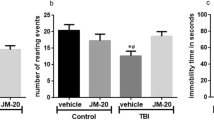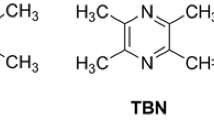Abstract
Traumatic brain injury (TBI) may trigger secondary injury cascades including endoplasmic reticulum stress, oxidative stress, and neuroinflammation. Unfortunately, there are no effective treatments targeting either primary or secondary injuries that result in long-term detrimental consequences. Huperzine A (HupA) is a potent acetylcholinesterase inhibitor (AChEI) that has been used treatment of Alzheimer’s disease (AD). This study aimed to explore the neuroprotective effects of HupA in TBI and its possible mechanisms. Repetitive mild closed head injury (CHI) model was used to mimic concussive TBI. Mice were randomly assigned into three groups including sham, vehicle-treated and HupA-treated injured mice. The HupA was given at dose of 1.0 mg/kg/day and was initiated 30 min after the first injury, then administered daily for a total of 30 days. The neuronal functions including motor functions, emotion-like behaviors, learning and memory were tested. Axonal injury, reactive oxygen species (ROS), and neuroinflammation were examined as well. The results showed that injured mice treated with HupA had significant improvement in Morris water maze performance compared with vehicle-treated injured mice. HupA treatment significantly attenuated markers of neuroinflammation and oxidative stress in the injured mice. Taken together, HupA was effective in reducing neuroinflammation, oxidative stress and behavioral recovery after TBI. HupA is a promising candidate for treatment of TBI.






Similar content being viewed by others
References
Acosta SA, Tajiri N, Sanberg PR, Kaneko Y, Borlongan CV (2017) Increased amyloid precursor protein and tau expression manifests as key secondary cell death in chronic traumatic brain injury. J Cell Physiol 232:665–677
Aungst SL, Kabadi SV, Thompson SM, Stoica BA, Faden AI (2014) Repeated mild traumatic brain injury causes chronic Neuroinflammation, changes in hippocampal synaptic plasticity, and associated cognitive deficits. J Cereb Blood Flow Metab 34:1223–1232
Cheng T et al (2016) Cerebroprotection of flavanol (−)-epicatechin after traumatic brain injury via Nrf2-dependent and -independent pathways. Free Radic Biol Med 92:15–28
Ding K, Wang H, Xu J, Li T, Zhang L, Ding Y, Zhu L, He J, Zhou M (2014) Melatonin stimulates antioxidant enzymes and reduces oxidative stress in experimental traumatic brain injury: the Nrf2–ARE signaling pathway as a potential mechanism. Free Radic Biol Med 73:1–11
Hayes JP et al (2017) Mild traumatic brain injury is associated with reduced cortical thickness in those at risk for Alzheimer’s disease. Brain. doi:10.1093/brain/aww344
Johnson MW, Stoll L, Rubio A, Troncoso J, Pletnikova O, Fowler DR, Li L (2011) Axonal injury in young pediatric head trauma: a comparison study of β-amyloid precursor protein (β-APP) Immunohistochemical staining in traumatic and nontraumatic deaths*. J Forensic Sci 56:1198–1205
Johnson VE, Stewart W, Smith DH (2013) Axonal pathology in traumatic brain injury. Exp Neurol 246:35–43
Kobeissy FH et al (2016) Cognitive impairments induced by concussive mild traumatic brain injury in mouse are ameliorated by treatment with Phenserine via multiple non-cholinergic and cholinergic mechanisms. PLoS One 11:e0156493
Kochanek PM et al (2016) Approach to modeling, therapy evaluation, drug selection, and biomarker assessments for a multicenter pre-clinical drug screening consortium for acute therapies in severe traumatic brain injury: operation brain trauma therapy. J Neurotrauma 33:513–522
Kumar A, Loane DJ (2012) Neuroinflammation after traumatic brain injury: opportunities for therapeutic intervention. Brain Behav Immun 26:1191–1201
Lee DJ et al (2015) Septohippocampal neuromodulation improves cognition after traumatic brain injury. J Neurotrauma 32:1822–1832
Lin C et al (2017) Omega-3 fatty acids regulate NLRP3 inflammasome activation and prevent behavior deficits after traumatic brain injury. Exp Neurol 290:115–122
Mannix R et al (2013) Clinical correlates in an experimental model of repetitive mild brain injury. Ann Neurol 74:65–75
Mannix R, Berkner J, Mei Z, Alcon S, Hashim J, Robinson S, Jantzie L, Meehan WP, Qiu J (2017) Adolescent mice demonstrate a distinct pattern of injury after repetitive mild traumatic brain injury. J Neurotrauma 34:495–504
Mao X-Y, Zhou H-H, Li X, Liu Z-Q (2015) Huperzine a alleviates oxidative glutamate toxicity in hippocampal HT22 cells via activating BDNF/TrkB-dependent PI3K/Akt/mTOR signaling pathway. Cell Mol Neurobiol 36:915–925
Mei Z, Qiu J, Alcon S, Hashim J, Rotenberg A, Sun Y, Meehan WP 3rd, Mannix R (2017) Memantine improves outcomes after repetitive traumatic brain injury. Behav Brain Res. doi:10.1016/j.bbr.2017.04.017
Perry VH, Nicoll JAR, Holmes C (2010) Microglia in neurodegenerative disease. Nat Rev Neurol 6:193–201
Ruan Q, Liu F, Gao Z, Kong D, Hu X, Shi D, Bao Z, Yu Z (2013) The anti-inflamm-aging and hepatoprotective effects of huperzine A in d-galactose-treated rats. Mech Ageing Dev 134:89–97
Ruan Q, Hu X, Ao H, Ma H, Gao Z, Liu F, Kong D, Bao Z, Yu Z (2014) The neurovascular protective effects of Huperzine a on D-galactose-induced inflammatory damage in the rat hippocampus. Gerontology 60:424–439
Scherer RW, Yang G, Wang Y, Tian J, Liu J-P (2013) Huperzine A for Alzheimer’s disease: a systematic review and meta-analysis of randomized clinical trials. PLoS One 8:e74916
Schumann J, Alexandrovich GA, Biegon A, Yaka R (2008) Inhibition of NR2B phosphorylation restores alterations in NMDA receptor expression and improves functional recovery following traumatic brain injury in mice. J Neurotrauma 25:945–957
Shu L, Wang C, Wang J, Zhang Y, Zhang X, Yang Y, Zhuo J, Liu J (2016) The neuroprotection of hypoxic preconditioning on rat brain against traumatic brain injury by up-regulated transcription factor Nrf2 and HO-1 expression. Neurosci Lett 611:74–80
Smith DH, Johnson VE, Stewart W (2013) Chronic neuropathologies of single and repetitive TBI: substrates of dementia? Nat Rev Neurol 9:211–221
Tabas I, Glass CK (2013) Anti-inflammatory therapy in chronic disease: challenges and opportunities. Science 339:166–172
Tu TM, Kolls BJ, Soderblom EJ, Cantillana V, Ferrell PD, Moseley MA, Wang H, Dawson HN, Laskowitz DT (2017) Apolipoprotein E mimetic peptide, CN-105, improves outcomes in ischemic stroke. Ann Clin Transl Neurol 4:246–265
Velosky AG, Tucker LB, Fu AH, Liu J, McCabe JT (2017) Cognitive performance of male and female C57BL/6J mice after repetitive concussive brain injuries. Behav Brain Res 324:115–124
Wang C-Y, Zheng W, Wang T, Xie J-W, Wang S-L, Zhao B-L, Teng W-P, Wang Z-Y (2011) Huperzine A activates Wnt/β-catenin signaling and enhances the Nonamyloidogenic pathway in an Alzheimer transgenic mouse model. Neuropsychopharmacology 36:1073–1089
Wang Y, Tang XC, Zhang HY (2012) Huperzine a alleviates synaptic deficits and modulates amyloidogenic and nonamyloidogenic pathways in APPswe/PS1dE9 transgenic mice. J Neurosci Res 90:508–517
Wheaton P, Mathias JL, Vink R (2011) Impact of pharmacological treatments on cognitive and behavioral outcome in the Postacute stages of adult traumatic brain injury. J Clin Psychopharmacol 31:745–757
Yang L et al (2017) DRα1-MOG-35-55 treatment reduces lesion volumes and improves neurological deficits after traumatic brain injury. Metab Brain Dis. doi:10.1007/s11011-017-9991-6
Zhu D, Lei Y, Yang L, Ye CY, Qin MY, Yang HY, Jiang HL, Tang XC, Zhang HY (2015) Involvement of intracellular and mitochondrial Aβ in the ameliorative effects of Huperzine A against oligomeric Aβ42-induced injury in primary rat neurons. PLoS One 10:e0128366
Acknowledgements
The authors would like to thank Dr. Jianhua Qiu for his assistance with the revision English language.
Author information
Authors and Affiliations
Corresponding author
Ethics declarations
Funding
This work is supported by a grant from Guangzhou Education Bureau (1201421151).
Conflict of interest
No competing financial interests exist.
Rights and permissions
About this article
Cite this article
Mei, Z., Zheng, P., Tan, X. et al. Huperzine A alleviates neuroinflammation, oxidative stress and improves cognitive function after repetitive traumatic brain injury. Metab Brain Dis 32, 1861–1869 (2017). https://doi.org/10.1007/s11011-017-0075-4
Received:
Accepted:
Published:
Issue Date:
DOI: https://doi.org/10.1007/s11011-017-0075-4




